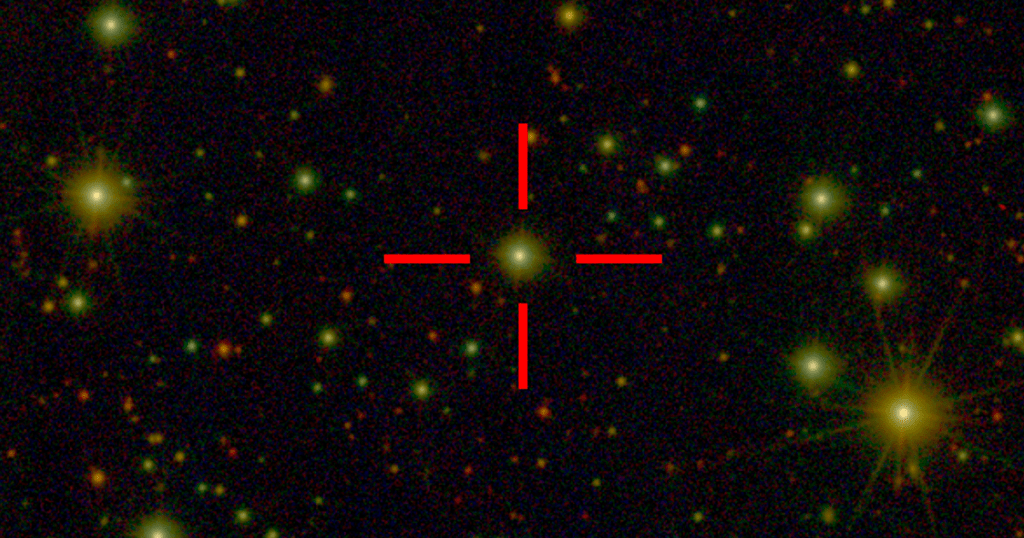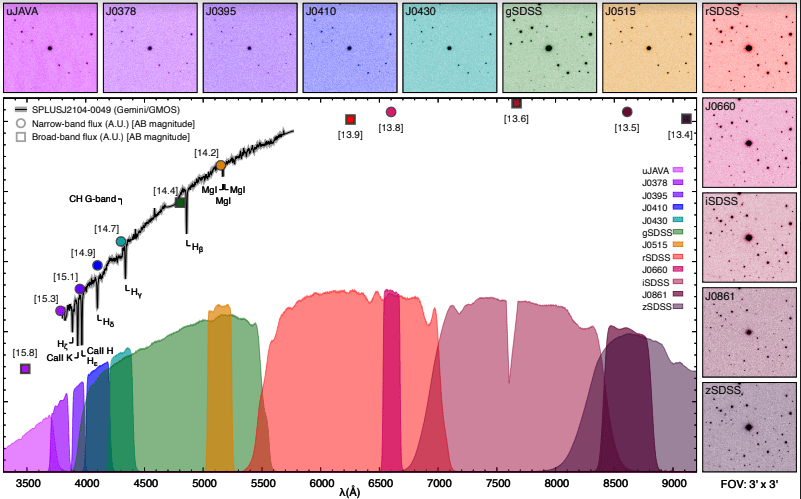With the participation of scientists from USP, the discovery was made in the characterization of 21 million celestial objects in the S-PLUS project

Art: Rebeca Alencar/Jornal da USP
A study published this month by the journal The Astrophysical Journal Letters (ApJL) reveals the discovery of a star belonging to the distinct group of ultra-metal-poor stars. The star, known as SPLUS J2104-0049, was selected to be observed by medium and high-resolution spectroscopy in two of the main telescopes in the world, the Gemini South and the Magellan Clay, both located in Chile. An important characteristic of the SPLUS J2104-0049 star is that it has the lowest abundance of carbon ever measured in a star of this type, which challenges the models that currently describe the evolution of the first stars. The discovery was made from the data obtained by the researchers of international project S-PLUS, which gathers over 100 scientists among researchers and students and is based at the Institute of Astronomy, Geophysics, and Atmospheric Sciences (IAG) of USP.

To astronomers, metals are all the chemical elements heavier than helium. “In the field of stellar archeology, it is believed that ultra-metal-poor stars were born from gas clouds enriched by the first generation of stars to form in the Universe. Currently, only 35 stars of this type are known”, explains Vinicius Placco, an associated scientist of the NOIRLab, based in Tucson, Arizona, United States, who lead the research. A special characteristic of the SPLUS J2104-0049 star is that it has the lowest abundance of carbon ever measured for an ultra-metal-poor star. “This challenges current models on the evolution of the first stars”, complements the researcher.
Placco’s research used as a basis the work by his doctoral student Devin Whitten, from the Notre Dame University, United States, who estimated stellar atmospheric parameters and carbon abundances for over 700 thousand stars from the second data release (DR-2) of the S-PLUS (an acronym for the Southern Photometric Local Universe Survey). This was also the first publication with carbon abundance estimates based on photometry. Usually, such physical parameters are obtained with the spectroscopy technique, in which light is separated as in a rainbow, which makes managing to analyze such a large number of stars impossible. The results of this work are essential to validate the theories of the formation and evolution of galaxies such as the Milky Way and also provide interesting candidates for future spectroscopic studies.
Map of the Southern Hemisphere sky
The S-PLUS is a project that is mapping the austral sky from Cerro Tololo (Chile) with a robotic telescope with a diameter of 86 centimeters (cm). The images for the project are obtained with a camera capable of recording a region of the sky equivalent to a square where two full Moons would fit loosely on each side. One of the differentials of the S-PLUS is the use of 12 photometric filters of the so-called Javalambre system, which uses seven filters more than most astronomic surveys. These seven additional filters are narrower and strategically selected to allow studying specific characteristics denominated spectral lines, which make it possible, for example, to measure the temperature and obtaining the chemical characterization of stars.

DR-2 represents the addition of data and images of an area with 950 squared degrees, triplicating the area studied so far available in the previous catalog. The images were obtained from 2016 and 2020 and include measurements of brightness in the 12 photometric bands of over 21 million new objects. The database has several tools for its exploration. “Those interested may obtain images from the regions of interest through a simple and friendly interface, and may assemble colored images at the same time”, says Gustavo Schwarz, a Computer Science student at the Mackenzie Presbyterian University and scientific initiation student at the IAG, who developed the system. “Besides, we made available a package that also allows directly downloading the project data.”

For a correct interpretation of the data, it was necessary to develop a special calibration technique for the S-PLUS, using calibration measurements from other projects. “Calibrations from similar projects are transformed for the 12-filter system used by the S-PLUS through the use of synthetic stellar models. This type of procedure allows optimizing the telescope time available for scientific observations, reducing by about 15% the time necessary to complete the project”, explains astrophysicist Felipe de Almeida Fernandes. Fernandes, who is a post-doctoral student at the Department of Astrophysics of the IAG, worked in the calibration efforts and leads the article submitted to the journal Monthly Notices of the Royal Astronomical Society (MNRAS) that describes the release of the DR-2 of the S-PLUS.
The new calibrations of the DR-2 allowed estimating important physical parameters such as temperature and chemical composition, especially the amount of carbon, for over 700,000 stars in the Milky Way. This gigantic effort also required calculation tools based on artificial neural networks that had to be “taught” first. With the volume of data obtained each night by the S-PLUS, it would be impossible for a human being to analyze and interpret all the pieces of information during an entire lifetime. To solve this type of problem, the analysis of the images and the processed data includes Artificial Intelligence algorithms.
Separating stars and galaxies
An example is the routine to separate stars, galaxies, and quasars developed to perform an appropriate classification without human intervention. For such, the program underwent “training” and learned to differentiate each type of object. “Besides including the brightness values of the 5 wide bands of the filter system, as is usually done, the S-PLUS program also included morphological characteristics obtained by the project itself, as well as data from the WISE satellite, which observed the entire sky in infrared”, explains Lilianne Nakazono, a doctoral student of the Department of Astronomy of the IAG, who is part of the group that makes the classification of objects. According to Lilianne, the algorithm’s hit rate exceeds 97%; in other words, for every one thousand objects classified, only 22 are incorrectly classified.

Clécio De Bom, a researcher at the Brazilian Center for Research in Physics (CBPF), also uses Artificial Intelligence to analyze the voluminous dataset of the S-PLUS, leading a project that applies deep neural network models to identify galaxy shapes automatically: spirals and ellipses. The work allows assessing the use of the 12 colors of the S-PLUS for this type of classification. “Due to the large amount of available data, this type of visual analysis becomes ever harder to be done by human specialists”, he ponders. “Additionally, various deep learning models have proved to be more efficient than humans in certain visual analyses. The number and proportion of different galaxy shapes are associated with the history of their formation and that of the structures in the Universe, such as galaxy clusters.”
Another example of the use of Artificial Intelligence refers to machine learning for obtaining the distances to objects that are beyond our galaxy. This technique allows determining the distance to the object through a statistical analysis of its brightness in the filters used by the project. “For training the algorithm, photometric databases were used such as the S-PLUS itself, the GALEX, a satellite intended to observe in ultraviolet, the 2MASS and the unWISE, which are projects for mapping the entire sky in infrared”, explains Erik Vinícius de Lima, a doctoral student at the IAG who participates in the study.
The S-PLUS project is an international project with the participation of researchers from countries such as Brazil, Argentina, Chile, the USA, and Spain, gathering over 100 scientists among researchers and students. The S-PLUS is based at the IAG, in São Paulo, and its lead researcher is Cláudia Mendes de Oliveira, a professor at USP. Roderik Overzier, a full researcher of the National Observatory, is a scientist in the project.
The S-PLUS was founded by USP, the National Observatory, the Federal University of Santa Catarina (UFSC), the Federal University of Sergipe (UFS), and the University of La Serena (Chile), with important contributions from the National Institute for Space Research (INPE) and the Center for Studies of Physics of the Cosmos of Aragon (CEFCA), and funding from the São Paulo Research Foundation (FAPESP), the National Council for Scientific and Technological Development (CNPq), the Coordination for the Improvement of Higher Education Personnel (Capes), the Rio de Janeiro Research Foundation (FAPERJ), and the Financier of Studies and Projects (Finep).
Participation as a member of the S-PLUS project (www.splus.iag.usp.br) is open to all scientists from Brazilian institutions. Several Brazilian researchers are also part of collaborations J-PLUS (www.j-plus.es) and J-PAS (www.j-pas.org), these in the Northern Hemisphere, the data of which, along with those of the S-PLUS, will cover almost half of the entire celestial sphere.